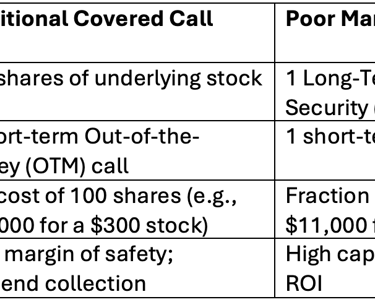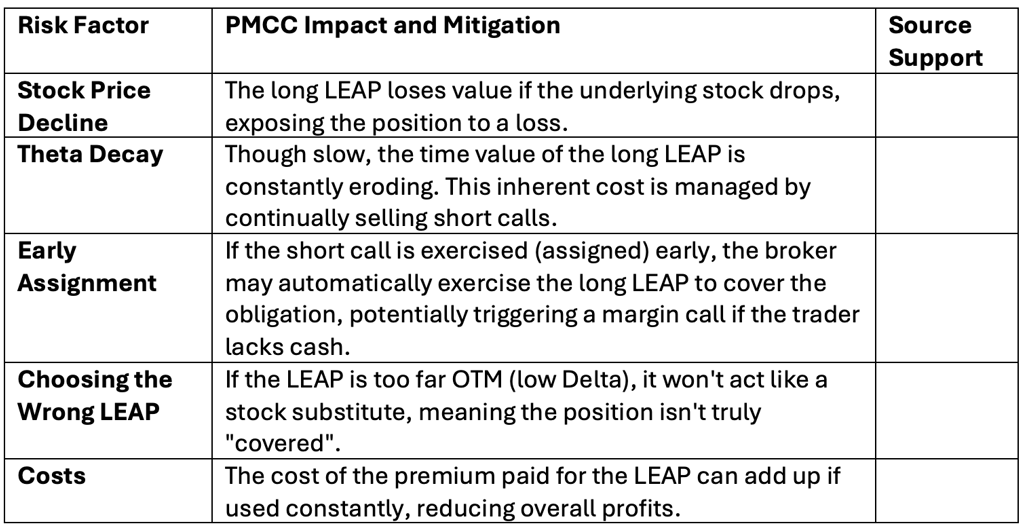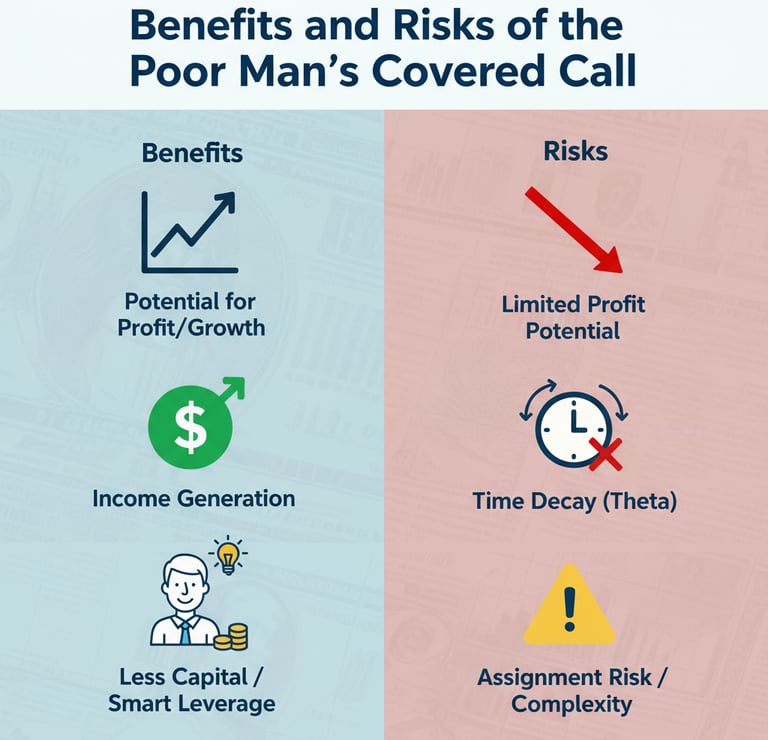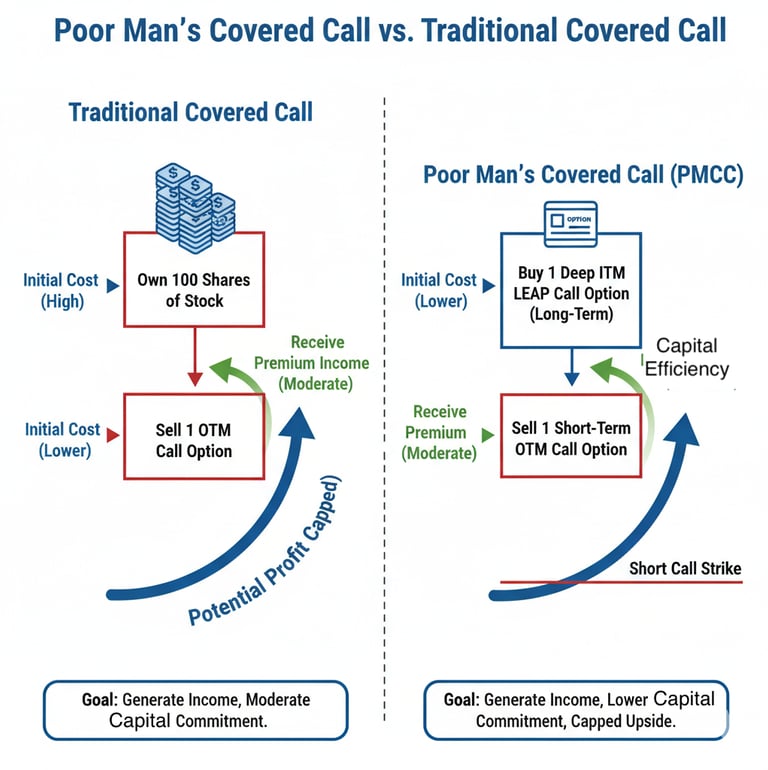Poor Man’s Covered Call: Income with LEAPs (PMCC Guide)
Master the Poor Man’s Covered Call (PMCC) strategy. Generate consistent monthly income using LEAP call options instead of stocks. Perfect for options for small accounts looking to leverage capital
OPTIONS TRADING
OraniaTech - Ben T.
10/30/202510 min read


The Poor Man’s Covered Call: Generating Income with Call LEAPs for Traders with Smaller Accounts
Do you dream of generating consistent monthly income through a disciplined options strategy but feel locked out because of the high initial capital requirements?
The cornerstone options income strategy—the Covered Call—requires you to own 100 shares of the underlying stock, which can tie up thousands, or even tens of thousands, of dollars in static capital. If you want to write a covered call on a stock trading at $300, you need $30,000 just to begin. This is a massive barrier, particularly for newer traders utilizing options for small accounts.
Why choose a Poor Man’s Covered Call over a traditional covered call?
The PMCC is an elegant, highly capital-efficient strategy that achieves the identical risk-reward profile of a traditional Covered Call, but for a significantly reduced cost. By substituting the expensive long stock position with a long-dated, cheaper option, the PMCC transforms into a powerful, leveraged income machine.
This guide, written for options trading for beginners and intermediate traders alike, will walk you through the mechanics of the PMCC, ensuring you understand how to use this financial scalpel to maximize yield and mitigate risk.
Quick Takeaway:
The Poor Man’s Covered Call uses LEAP calls instead of owning shares, letting traders with smaller accounts earn consistent income for a fraction of the capital.
1. Defining the Poor Man’s Covered Call (PMCC)
The Poor Man’s Covered Call is simply a variation of the Long Diagonal Spread. It functions as a synthetic covered call because it replicates the financial behavior of owning stock and selling a call against it.
Traditional Covered Call vs. PMCC


The name "Poor Man's" comes from the fact that this strategy dramatically lowers the required capital, making it accessible to many more investors.
2. Core Mechanics: How the PMCC Works
The PMCC involves two distinct, simultaneous transactions, constituting a Long Diagonal Spread:
Leg 1: Buying the Deep ITM LEAP Call Option (The Stock Substitute)
Instead of committing full capital to 100 shares, you purchase a single LEAP call option. LEAPs are options that have a long time to expiration—anywhere from nine months to three years.
Long Expiry: You select an expiration date at least 9 months to a year out. This extended time minimizes the impact of Theta decay (time value erosion).
Deep In-The-Money (ITM): The strike price must be significantly below the current stock price. Buying a deep ITM call maximizes its Intrinsic Value and ensures its Delta (\Delta) is high, ideally near 1.0 (or 100). A Delta near 1 means the option price moves almost dollar-for-dollar with the stock price, effectively mimicking the performance of the actual stock.
This long LEAP option serves as the "cover" or protection for the second leg of the trade, fulfilling the requirement of the traditional covered call.
Leg 2: Selling the Short-Term OTM Call Option (The Income Generator)
Against your protective LEAP, you sell (write) a short-dated call option.
Short Expiry: This option should typically expire in 30 to 45 days. This timeframe is the sweet spot for option sellers because the time decay (Theta) accelerates sharply once an option is within 30 days of expiration.
Out-of-the-Money (OTM): You want the strike price to be comfortably above the current stock price. This is done to maximize the premium received from Time Value (extrinsic value), as OTM options have no intrinsic value.
By executing this call LEAPs strategy, you receive cash immediately (the premium from the short call), which reduces the net cost of the entire position.
💡 Pro Tip: Choose LEAPs with Delta above 0.85 to maintain a strong correlation with the stock and protect your cover.
3. Advantages, Risks, and Comparison
Key Advantages of the PMCC
Lower Capital Requirement: This is the primary driver. By substituting shares with a LEAP, you significantly reduce the cash needed to enter the trade.
Increased ROI Potential: While the cash premium collected is similar to a traditional CC, the percentage return on invested capital is much higher because the capital base is smaller.
Risk Mitigation: Options, by design, are risk-management tools. Although the PMCC carries risk, the cost of the position is capped at the net debit paid, protecting your capital better than a traditional CC if the stock plummets to zero.
Flexibility: The PMCC is an excellent covered call income strategy that allows you to collect premium monthly.
Risks and Limitations


💡 When NOT to use PMCC
Avoid PMCC when implied volatility is unusually high, or when earnings announcements are near. The inflated LEAP prices can eat into your returns.
4. Practical Example: PMCC on SPY
Let's illustrate the PMCC strategy using the SPY ETF, a common index-tracking security suitable for this strategy.
Scenario (Assumed Prices just):
SPY Price: $650.00
Traditional CC Cost: $65,000 (100 shares)
PMCC Setup (Long Diagonal Spread):
Buy LEAP (Stock Substitute): Buy 1 SPY ITM Call: Strike $600.00, Expiry 365 days out (LEAP). Price: $60.00 per share ($6,000 total debit).
Sell Short Call (Income): Sell 1 SPY OTM Call: Strike $655.00, Expiry 45 days out. Price: $3.00 per share ($300 total credit).
Net Cost and Results:
Total Initial Cost (Net Debit): $6,000 (LEAP) - $300 (Premium) = $5,700.
Income Generated: $300 over 45 days.
Percentage ROI (Annualized): A gain of $300 on capital of $5,700 over 45 days is roughly a 5.26% return, which annualizes to approximately 42.6%.
Conclusion: The PMCC achieved a powerful cash flow stream for just 8.7% of the capital required for a traditional covered call ($5,700 vs. $65,000).


5. Advanced Tips and Managing the Position
Successful PMCC execution relies on actively monitoring the short call and the underlying asset.
How to Roll the Short Call
The act of "rolling" the short call is the most crucial part of maintaining the covered call income strategy. You aim to capture the premium and avoid assignment while continuing to collect new income.
If the short option nears expiration (e.g., 7 days left) or loses a significant portion of its time value, you roll the trade:
Buy to Close: Purchase the existing short call to remove your obligation (e.g., buy it back for $0.50 of its original $3.00 premium, netting a $250 profit).
Sell to Open: Immediately sell a new short call further out in time (e.g., 45 days away) or slightly higher in strike price, collecting a fresh premium.
This rolling mechanism allows you to continuously generate profits from Theta decay while holding the capital-efficient LEAP.
Managing Delta Exposure (The "Cover")
Since the long LEAP is acting as your substitute stock, you need to ensure it maintains a high Delta (near 1.0).
If the underlying stock rises, the LEAP’s Delta will increase (approaching 1.0).
If the underlying stock falls significantly, the LEAP moves closer to At-The-Money (ATM), and its Delta drops (closer to 0.5). A low Delta means your cover is weakening, and the entire PMCC position becomes riskier.
To maintain a strong cover, you should choose deep ITM LEAPs with the highest initial Delta possible.
Rules-Based Exit Strategies
Discipline is key. Since option profits are often less, you must stick to rules:
The One Percent Rule: If the extrinsic value of your short call falls below one percent of the underlying price, roll the option over. This is an efficient way to lock in most of the premium before accelerating decay diminishes the cost advantage of buying the option back.
Taking Profits: Many traders automatically buy back the short call once it reaches 50% of the maximum potential profit, as this balances risk and reward.
6. Common Mistakes to Avoid with PMCC
Even experienced options traders can make mistakes. By being aware of these pitfalls, you improve your chances of success.
Picking LEAPs Too Far OTM: This is the most common error. If you choose a LEAP that is too far OTM, its Delta will be too low, meaning its value won't track the underlying stock effectively. This makes the position severely vulnerable if the underlying drops.
Selling Calls with Too Little Premium: Some traders look too far OTM on the short call, resulting in a tiny premium. While this minimizes assignment risk, the premium collected may not cover the slow, steady erosion of Theta decay on the long LEAP.
Neglecting Margin Requirements: Although the PMCC is defined-risk, it is a combination strategy (a diagonal spread). Certain brokers may require additional margin to cover the theoretical risk, especially around expiration. Always check with your broker to fully understand the position's true cost and risk.


7. Summary
The Poor Man’s Covered Call is a highly effective, disciplined strategy for generating income with call LEAPs that democratizes the powerful covered call technique. It requires minimal capital compared to traditional investing and provides extraordinary leveraged returns.
By mastering the mechanics of selecting a deep ITM LEAP (your low-cost stock substitute) and strategically rolling your short OTM calls (your monthly income generator), you gain the ability to generate cash flow in sideways markets. This shift in strategy transforms options from a perceived gambling tool into a professional risk management and income tool.
The complexity of options is real, but the path to mastery is simple: mechanics first, emotions second.
We encourage you to begin your journey toward consistent income by implementing the PMCC strategy in a paper trading environment first. Practice the setup and management, see the results, and let the historical data convince you before committing real capital. Leverage the power of options for small accounts to accelerate your wealth-building goals.
Start paper trading your first Poor Man’s Covered Call today — learn, test, and see how small capital can yield big consistency.
🧠 FAQ: The Poor Man’s Covered Call (PMCC) Strategy
❓ 1. What is the Poor Man’s Covered Call strategy?
The Poor Man’s Covered Call (PMCC) is a capital-efficient alternative to the traditional covered call strategy. Instead of owning 100 shares of stock, you buy a deep in-the-money LEAP call (a long-term option) and sell a short-term callagainst it. This setup mimics the payoff of a covered call but requires much less capital.
❓ 2. Why is it called the “Poor Man’s” Covered Call?
It’s called the “Poor Man’s” Covered Call because it lets traders replicate the same income strategy as wealthy investors who can afford 100 shares of expensive stocks — but at a fraction of the cost. Instead of tying up tens of thousands of dollars, a trader can control a position using LEAPs for 70–90% less capital.
❓ 3. How does the PMCC generate income?
Income comes from selling short-term out-of-the-money (OTM) call options against your long LEAP position. These short calls decay in value as expiration approaches (Theta decay), allowing you to buy them back cheaper or let them expire worthless — then repeat the process for consistent monthly or biweekly income.
❓ 4. What are LEAPs and why are they used in this strategy?
LEAPs (Long-Term Equity Anticipation Securities) are options with expirations typically 9 months to 3 years in the future. They’re used as stock substitutes in the PMCC because deep in-the-money LEAPs have high Delta (close to 1.0), meaning they move almost dollar-for-dollar with the underlying stock — similar to owning shares, but at much lower cost.
❓ 5. How much capital do I need to start a Poor Man’s Covered Call?
It depends on the stock’s price and the chosen LEAP. For example, if a stock trades at $300 and the LEAP costs $11 per share, one contract (100 shares equivalent) costs $1,100 instead of $30,000 to own the shares outright. This makes the PMCC ideal for smaller trading accounts looking to generate option income efficiently.
❓ 6. What are the key advantages of using the PMCC?
Lower capital requirement – use LEAPs instead of stock.
Higher ROI potential – same income on smaller investment.
Defined risk – maximum loss limited to the cost of the LEAP.
Flexibility – can be managed, rolled, and adjusted monthly.
Income generation – steady cash flow in sideways or mildly bullish markets.
❓ 7. What are the risks of the Poor Man’s Covered Call?
While the PMCC is efficient, it’s not risk-free. The main risks include:
Stock price decline: your LEAP can lose value if the stock falls.
Theta decay: the LEAP’s time value slowly erodes over time.
Early assignment: the short call could be exercised before expiration.
Incorrect strike selection: choosing a LEAP with too low Delta may reduce your “cover” efficiency.
❓ 8. How do you manage or “roll” a PMCC position?
Rolling means closing your existing short call and opening a new one further out in time or at a different strike. Traders often roll the short call every 30–45 days to capture new premium income while keeping the long LEAP open as the base of the position. This ongoing process is how the PMCC generates continuous income.
❓ 9. Can the Poor Man’s Covered Call lose money?
Yes. If the underlying stock price drops significantly, the LEAP will lose intrinsic value, and the premiums from short calls may not offset that loss. The maximum potential loss is the net debit paid for the LEAP minus collected premiums, but it’s still much lower than owning 100 shares outright.
❓ 10. Is the PMCC a good strategy for beginners?
It’s a great next step after understanding basic options concepts like calls, puts, and covered calls. The PMCC teaches traders about time decay, Delta management, and rolling mechanics, but beginners should always start with paper trading to understand the behavior before using real money.
❓ 11. How do I choose the right LEAP and short call strikes?
For the LEAP: choose a deep ITM strike (Delta between 0.85–1.0).
For the short call: pick a near-term OTM call (30–45 days to expiry) that offers decent premium but low assignment risk.
This balance allows the PMCC to mimic a true covered call with consistent premium collection.
❓ 12. When should I avoid using the PMCC?
Avoid the PMCC when:
The underlying stock has very high implied volatility (LEAPs will be overpriced).
Earnings or major news events are approaching.
The stock is trending sharply downward (the LEAP will decay faster than income collected).
In these cases, it’s better to wait for stable or neutral conditions before deploying the strategy.
❓ 13. What’s the best way to practice the PMCC safely?
Start with paper trading or a demo account. Use historical charts to simulate different LEAPs and short call combinations. Once comfortable, apply the strategy with a small portion of your portfolio, using high-quality, liquid tickers like SPY, AAPL, or MSFT to minimize execution risk.
❓ 14. How does the PMCC compare to other options income strategies?
Compared to other income strategies like cash-secured puts or iron condors, the PMCC offers leverage and directional exposure similar to owning stock. It’s best suited for traders who prefer steady income with moderate bullish bias — without needing full stock ownership or large cash reserves.
❓ 15. Can the PMCC be used in an IRA or tax-advantaged account?
Yes — many brokers allow long diagonal spreads (PMCCs) in IRAs, as they are defined-risk strategies. However, short options within IRAs can have specific approval levels, so check with your broker to ensure compliance before trading.


